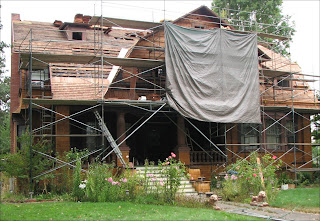 |
 |
 |
The old dark house was wrapped in a blanket of fog that August evening, the sky moonless. Although it was near the peak of summer there was a seeping chill. In the distance, a beast howled.
TOP: Start of the roof tearoff. Notice the tarp-covered frames to protect the plants |
Then suddenly from the attic, footsteps. First a heavy step, then in stumbling fashion, another clumsy tread, then another. Then another. Moving closer.
"Someone is upstairs!" I exclaimed, bolting from my chair. Up the steps into the dark I flew, a flashlight in one hand, a claw hammer in the other. My heart pounded as I ripped open the attic door, expecting the worst.
My flashlight's beam probed every corner as I sought that lurker in the dark, yet no skulking invader awaited. I was the only person in the attic. Living person. Clearly: Proof of a ghostly encounter. The footsteps were of the murderous tycoon James Oates, or any of the better souls who died in this very place.
Or perhaps... were the lumbering footsteps actually lumber? Could the sounds merely be a cascade of creaks caused by temperature and stress fluctuations in the century-old rafters, floor joists, and beams, after about two tons of old shingles were removed from the roof? Was the howling beast possibly our neighbor's lovable beagle? Was the homeowner in the attic with a hammer easily spooked? Could a blog update offer a more belabored intro? Who can say for sure?
The tearoff of the eastern roof was certainly dramatic; almost all of the living space in Comstock House is on that side, and soon after the demolition began, a new draft pulled through the entire house, even when the attic door was closed. Soon after came a faint smell of something very old (think of Dickens' dismal Miss Haversham) and by evening, a thin layer of talcum-like dust was everywhere. I sneezed for two days, when I wasn't charging into the attic with a hammer.
The mostly chill days of August were the busiest yet for the Comstock House restoration project. Most mornings found Filipe Garcia, sometimes supported by another worker from Ridgeline Roofing, methodically laying new shingles over the old sheathing boards, which were already dotted with nails from (at least) two previous roofs. Jim Scotchler continued shingling the white cedar sidewall. A dozen other contractors came and went, the driveway always blocked by trucks.
The groaning house and blanket of microdust aside, the most noteworthy event of the month was the discovery that the house originally had a bizarre gutter system, as discussed at length in a separate post on the Restora Obscura blog. Superior Seamless Gutter of Santa Rosa also came by and fabricated a 58' long gutter for the front of the house.
The greatest challenges were restoring the windows and frames, which suffer far more weather on the east than any other face of the house. But the experienced gained from a year of breath-holding work sessions during the 2007 restoration of an attic window now paid a reward. This summer there were eleven distressed windows removed at one point, all moving between the basement workshop and outdoor tables for various stages of repair.
| |||
All of the attic windows and most of the ones on the second floor had at least one lower joint that had separated. The top window at left below only needed glue and a clamp to bring the mortise and tendon back together; the window beneath was in far worse shape, with a large section of the stile rotted away. To restore it, I made a form on the window side and the bottom using popsicle sticks held in place with push-pins. (If I ever write a book on the Comstock House restoration, a chapter will be called, "Toothpicks, Popsicle Sticks, and Tiny Dental Tools.") The photo in the center shows the area filled with epoxy as viewed from the bottom of the window.
The final image below shows the same window in the process of glazing, using an unorthodox technique of my own. First I crudely pack the window with fresh, warmed putty - DAP 33 only, please. It should have the consistency of room-temperature butter; the only goal is to ensure the putty has good adhesion to the glass and wood. After it has dried for two or three days the putty will be firmed up similar to cold cream cheese, and you can make the 45° cut with a utility knife. Half (or more) of the putty will be sliced off and thrown away. Dip the end of a flat edge glaziers tool in linseed oil and drag it over the putty to achieve a smooth line. The linseed oil also helps the putty tighten when it dries. Allow it to sit in the sun for at least a week before painting. This technique is time-consuming, but overall less labor intensive than trying to finish glazing in one session.
 |  |
Subscribe to:
Post Comments (Atom)




0 comments:
Post a Comment